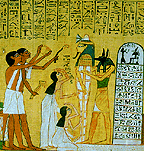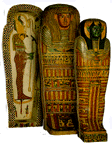![]()
What is a Mummy ?
![]()
Mummies
are
When
you think of a mummy what comes to mind? Most of
ususually picture an Egyptian mummy wrapped in bandages and
buried deep inside a pyramid. While the Egyptian ones are the
most famous, mummies have been found in many places throughout
the world, from Greenland to China to the Andes Mountains of
South America.
A mummy is the body of a person (or an animal) that has
been preserved after death. Normally when we die,
bacteria and other germs eat away at the soft tissues (such as
skin and muscles) leaving only the bones behind. Since bacteria
need water in order to grow, mummification usually happens if the
body dries out quickly after death. The body may then be so well
preserved that we can even tell how the dead person may have
looked in life. Mummies are made naturally or by
embalming, which is any process that people use to help preserve
a dead body. Mummies can be dried out by extreme cold,
by the sun, by smoke, or using chemicals such as natron. Some
bodies become mummies because there were favorable natural
conditions when they died. Others were preserved and buried with
great care. The ancient Egyptians believed that
mummifying a person's body after death was essential to ensure a
safe passage to the afterlife.
How
r mummies made ?
Mummification
in ancient Egypt was a very long and expensive process.
From start to finish, it took about seventy days to embalm a
body. Since the Egyptians believed that mummification was
essential for passage to the afterlife, people were mummified and
buried as well as they could possibly afford. High-ranking
officials, priests and other nobles who had served the pharaoh
and his queen had fairly elaborate burials. The pharaohs,
who were believed to become gods when they died, had the most
magnificent burials of all. In the case of a royal or
noble burial, the embalmers set up workshops near the tomb of the
mummy.
The
art of Egyptian mummification consisted of many steps. First, the
body was washed and ritually purified. The next step was to
remove the deceased person's inner organs. A slit was
cut into the left side of the body so that the embalmers could
remove the intestines, the liver, the stomach and the lungs. Each
of these organs was embalmed using natron, which served to dry
out the organs and discourage bacteria from decaying the tissues.
The organs were then individually wrapped using long
strips of linen and placed in canopic jars. The lids of
these jars were fashioned after the four sons of Horus, who were
each entrusted with protecting a particular organ.
 |
 |
 |
Here
are some canopic jars with lids depicting the four sons of Horus:
Qebehsenuef,
the falcon head -- intestines
Duamutef, the jackal head -- stomach
Hapy, the baboon head -- lungs
Imsety, the human head -- liver
|
After the removal of the inner organs, the body cavity was stuffed with natron. The brain was then removed through the nose using long hooks. Since the ancient Egyptians considered the brain unimportant, it was probably thrown away.
The body was then placed on a slanted embalming table and completely covered with natron. This allowed fluids to drip away as the body slowly dried out. This part of the process took about forty d ays, after which the natron was removed, inside and out, to reveal a dried, shrunken body. After another cleaning, the body was rubbed with unguents to aid in preserving the mummy's skin. The head and body cavity were stuffed with packing.
The
mummy was then prepared for bandaging. First, the
embalming cut in the side of the body was sewn up and covered
with a patching depicting the protective eye of Horus. The body
was adorned with gold, jewels and protective amulets. Fingers and
toes were covered with protective gold caps and individually
wrapped with long, narrow strips of linen. Arms and legs were
also wrapped, then the entire body was wrapped to a depth of
about twenty layers. The embalmers used resin to glue the layers
of wrappings together. The wrapped head was covered with a mummy
mask. Finally, the last layer of bandages went on and was given
one last coating of resin. The mummy was the ready for burial. Once
the mummy was finally prepared, it was time for the funeral.
The mummy and its canopic jars were transported by sled from the
embalming tent to the tomb. People were hired to demonstrate
their grief by crying and throwing dust on their hair. At the
site of the tomb, religious ceremonies were held to prepare the
dead for the afterlife. In particular, the Opening of the Mouth
ceremony was believed to allow the mummy to see, hear, eat and
drink in the spirit world.
Who
r the mummy ?
Over time almost all Egyptians who could afford to became
mummies when they died -- a total of about 70 million mummies in
3,000 years. By the 4th century AD, many Egyptians had
become Christians and no longer believed that mummification was
necessary for life after death. Eventually, the Egyptians gave up
the art and science of making mummies.
So
where did all the mummies go? Sadly, most were plundered
in ancient times by grave robbers and vandals looking for
treasures wrapped up in the bandages. Countless mummies were also
destroyed during the Middle Ages, when they were ground into
powders to make supposedly magical potions.
Later on, modern treasure hunters blundered into their tombs
looking for artifacts and souvenirs.
Even industry aided the destruction by using mummies' bandages to
make paper or burning their bodies for fuel.
The best preserved mummies are those of the pharoahs and
their relatives. These mummies tended to be more
carefully embalmed and protected from harm. The mummies that have
survived allow us to look back into the past and know something
of the ancient Egyptians and their time. Three of the most famous
Egyptians mummies are Tutankhamen, Seti I and Rameses II (Ramses
the Great).
Tutankhamen, known to many as King
Tut, was probably just a boy when he was crowned pharoah in the
18th Dynasty. He was still a teenager when he died of unknown
causes and was entombed in the Egyptian Valley of Kings. Although
Tutankhamen was not one of the more distinguished or important
pharoahs in his own time, he has a very special place in ours.
Tutankhamen's
tomb was discovered in 1922 by Howard Carter. Over the next
several years, Carter's expedition carefully uncoverd the riches
within, including the gold mask above. A number of mysterious
deaths that followed the opening of the tomb set off wild rumors
of a mummy's curse.
Today,
Tut is known to countless people the world over, in part because
his is the only pharoah's tomb ever discovered intact. Tut's
burial site had somehow escaped pillaging by grave robbers for
over 3000 years. His mummy and its magnificent solid gold
sarcophagus, along with wall paintings, furniture, weapons, games
and other artifacts have survived to the present, giving us a
unique glimpse at the trappings of an ancient pharoah.
Rameses the Great
ruled over Egypt from 1279-1212 BC, an incredible 67
years. Rameses was legendary in many respects. At a time when
most people lived only a few decades, Rameses was about 90 years
old when he died. He was a tall man about six feet in height,
when the average Egyptian was a little over five feet tall.
Rameses had many wives in his lifetime and is believed to have
fathered over 100 children. In 1974, Egyptologists at the Cairo
Museum noticed that the mummy's condition was getting worse
rapidly . They decided to fly Rameses II to Paris so that a team
of experts could give the mummy a medical examination. Did you
know that even a mummy needs a passport to travel? Ramses II was
issued an Egyptian passport that listed his occupation as
"King (deceased)."
Once in
Paris, Rameses was diagnosed and treated for a with a fungal
infection. During the examination, scientific analysis revealed
battle wounds and old fractures, as well as the pharoah's
arthritis and poor circulation. In addition, experts were able to
determine some of the flowers and herbs that were used for the
embalming, including lots of camomile oil.
 |
 |
![]()
![]()